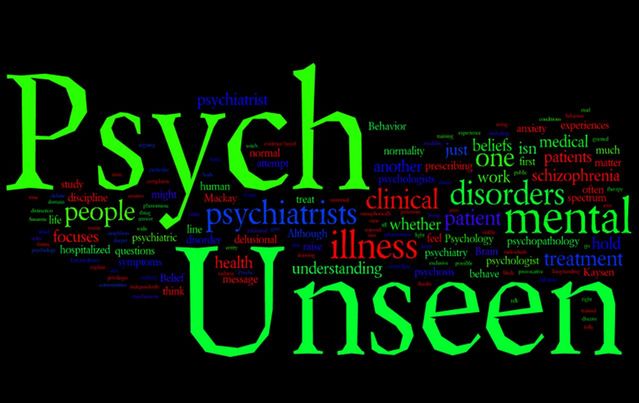Psychiatry
Psych Unseen: Brain, Behavior, and Belief
Uncovering the psychiatry of everyday life
Posted June 5, 2014

As a psychiatrist, I’m often asked what the difference is between a psychiatrist and a psychologist. The simplest answer is that psychiatrists are medical doctors who are trained to diagnose and treat mental disorders, using a predominantly medical model as our framework of understanding. As such, while both psychiatrists and psychologists use psychotherapy (“talk therapy”) as a treatment modality, psychiatrists have historically enjoyed exclusive domain over prescribing medications, though that has been changing more recently as psychologists with additional training have been granted prescribing privileges in some states.
But the difference between psychiatrists and psychologists runs much deeper than that. Psychiatry, in its modern incarnation, is a medical discipline that focuses on the treatment of people with mental disorders such as schizophrenia, major depression, anxiety disorders, and dementia. Psychology, on the other hand, is a largely scientific discipline that has a much broader scope that extends beyond the clinical in its aim to study and understand all mental phenomena — how we think, reason, feel, and behave — whether normal or abnormal.
This blog, Psych Unseen: Brain, Behavior, and Belief intends to draw from both traditions in an effort to discuss how the study of mental illnesses can help inform our understanding of normal mental processes. Put another way, Psych Unseen will attempt to uncover and highlight the “psychiatry of everyday life.”
Although debates about what is and isn’t mental illness are inevitable, with some arguing that there is no such thing as psychiatric disorders at all, my clinical practice focuses on the treatment of hospitalized patients for whom few would raise such questions. As a full-time psychiatrist and part-time clinical researcher, my work focuses on the treatment of hospitalized patients with severe mental illness who are often struggling with the basic ability to function independently.
Although I treat patients with a wide variety of conditions, my clinical and research focus has been on understanding and treating people who suffer from psychotic disorders such as schizophrenia. I have a longstanding interest in the hallmark symptoms of psychosis including delusions and hallucinations, with particular curiosity about what happens in the brain and in the life experiences of individuals to cause such breaks from reality.
Once I had a patient who threw himself off a freeway overpass, believing that there was another entity living inside his body that was controlling his actions. He meant this literally, not metaphorically, and therefore refused to say that the serious injuries that he sustained were the result of a suicide attempt. What mechanisms could explain how such a delusional belief might take such a pernicious hold in one’s psyche?
While I am endlessly intrigued by such questions relating to psychosis, I am just as interested in the grey area between clear-cut psychopathology and normality. In clinical work, psychiatrists must routinely ask themselves whether it is possible that nothing is “wrong” with a patient, despite the complaints of that patient (or for that matter, complaints about the patient by other people). We all hold beliefs that our neighbors likely disagree with and we privately behave in ways that might raise an eyebrow in public — what is it that determines whether we are delusional, fanatical, superstitious, eccentric, or merely creative?
In 1841, Charles Mackay first published the now classic work, Extraordinary Popular Delusions and The Madness of Crowds, a provocative account of various historical infatuations and crazes that have swept over society such as tulip mania, alchemy, fortune telling, and witch hunts. In it, he writes, “We find that whole communities suddenly fix their minds upon one object, and go mad in its pursuit; that millions of people become simultaneously impressed with one delusion, and run after it, till their attention is caught by some new folly more captivating than the first."
Is that the case? If Mackay’s view is right, then perhaps there is a little psychiatric disorder in all of us and the line that separates mental health and mental illness is one that can be easily straddled or traversed back and forth. In my experience, this is just so. The distinction between mental health and mental illness can be best modeled as a spectrum in which there is a qualitative difference between having a mental disorder like schizophrenia and not having it (just as there is a difference between blue and green in the visible light spectrum), but in which the difference is also a matter of degree (or wavelength).
To be clear, the take-home message here isn’t that “everyone is crazy,” as some seem to suspect we psychiatrists think. In the movie adaptation of Susanna Kaysen’s Girl, Interrupted, Kaysen’s character says, “Crazy isn’t being broken or swallowing a dark secret. It’s you, or me… amplified.” In that sense, the real message is that people with mental illness aren’t some “others” who have lost their humanity. In contrast to full blown mental disorders, individual symptoms of mental illness, such as anxiety, sadness, anger, impulsivity, forgetfulness, and unconventional beliefs are human experiences shared by all of us at one time or another.
Psych Unseen: Brain, Behavior, and Belief aims to explore the fluid line and potential overlap between psychopathology and normality, drawing from the perspectives of psychiatry, neuroscience, psychology, and evidence-based medicine to address timely topics related to mental health, mental illness, human behavior, and how we come to hold popular and not-so-popular beliefs.
Thanks to Psychology Today for providing a forum to do so and thanks to all future readers of Psych Unseen. Please feel free to leave a comment — respectfully articulating different sides of any debate is encouraged!




